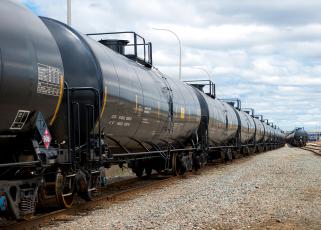In a recent post we reviewed refining capacity, which for the United States is the maximum volume of crude oil that all 125+ American refineries, combined, can process in a given day according to their individual design specifications. Today, we’re tackling utilization, because in the real world, running refineries at 100% isn’t sustainable or safe for any long stretch of time.
So while capacity tells us how much crude oil refineries are able to process, utilization tells us how much is actually being processed. Thus, utilization is just as relevant in conversations about global fuel supply and demand.
Let's take a closer look. (spoiler alert: utilization is another energy metric where the United States consistently leads the world). We may be down 1.1 million barrels of daily petroleum refining capacity compared to early 2020, but we’re still the number one refining country by volume. American refineries are running full-out, at about 95% of total capacity, contributing more fuel—gasoline, diesel, jet fuel, etc.—to the global market than any other country. In fact, U.S. refineries process more crude oil every day than the United States produces, and we make more finished fuels than the United States consumes.
Q: What is refinery utilization and what’s considered “high” utilization?
Refinery utilization measures how much crude oil refineries are processing or “running” as a percentage of their maximum capacity. It tells us roughly how much of our refining muscle is being put to work manufacturing fuel.
For the United States, anything in the ballpark of 90% or higher is considered a “high” utilization rate.
Q: What is our refinery utilization rate in the United States, and how does it compare to previous years?
As of July 1, U.S. refineries were operating at an average utilization rate of nearly 95%, essentially back to pre-pandemic highs. In normal years, U.S. refineries typically operate at around 90% of utilization or higher, as you can see below:
- 2021: 86% (COVID impact)
- 2020: 79% (COVID impact)
- 2019: 91%
- 2018: 93%
- 2017: 91%
- 2016: 90%
- 2015: 91%
- 2014: 90%
U.S. refineries have been able to maintain high utilization rates over time because our refining industry is the most competitive in the world and our facilities are among the most advanced and well-maintained.
Q: How do global run rates compare?
Global refinery utilization as of June 2022 was about 79% (≈80 million barrels/day [MMBD] throughput out of 101 MMBD total capacity), much lower than utilization in the United States for some of the reasons stated above and also because many of the world’s refineries are facing significantly higher operating costs with the global surge in natural gas prices. Of the countries with the most refining capacity—the United States, China and Russia—only the United States is currently operating refineries above 90%. Russia has cut refinery utilization this year in the wake of its assault on Ukraine and resulting embargoes on Russian energy and refined products, and China is operating its significant refining capacity well below 80%.
Q: What causes refineries to reduce the amount of crude they process, and how much can we blame COVID for lower utilization in the past couple years?
Refineries do not run at 100% for long stretches of time, and they’re not meant to. Refineries will reduce inputs or “cut runs”—and thus reduce utilization—for a number of reasons:
- Planned facility maintenance (which in the United States tends to happen in the first or second quarters of each each year when fuel demand tends to be lower)
- Hurricanes and other storms
- Demand destruction tied to events like the COVID-19 pandemic
Both planned maintenance and weather-related shutdowns happen for the sake of minimizing risk and maintaining safe, reliable refinery operations for the long-term. Demand destruction is a different driver.
The major global dip in refinery utilization in 2020 is almost entirely connected to COVID lockdowns. Refineries are so far downstream—and so close to end consumers—in the fuel supply chain that industry utilization rates adapt quickly to align with demand. If consumers aren’t buying fuel, refineries can’t keep making it because infrastructure would quickly bottleneck.
With various stay-at-home orders in place throughout the world, fuel demand plummeted in the first half of 2020. Most refiners cut runs drastically in response and maximized flexibility to increase diesel outputs since demand for that fuel was considerably less impacted by the pandemic than demand for gasoline and jet fuel (20% declines for diesel, compared to 44% and 70% declines for gasoline and jet fuel).
Q: Is there a minimum utilization rate for refineries?
Yes, it’s called the “turndown rate.” It’s the lowest volume of crude a refinery can process and still safely keep all units operating. In terms of refinery utilization, that’s about 65% to 70% of a facility’s total capacity. Early on in the COVID lockdowns, U.S. refineries dropped utilization to 68%, right at that level.
Q: What comes first: lower utilization or lower capacity?
Utilization cuts are meant to be temporary. In the United States, our utilization tends to always be high, near or above 90%, with different parts of our capacity subbing in and out as others undergo maintenance.
Capacity losses are often permanent. The choice to idle or permanently close a refinery is made taking into account years of data, regulatory and political signals and future demand projections. If projections and politics suggest there will be lower sustained demand in the future, the economic course of action may be to shutter capacity where competitiveness and profitability are in question. That has happened in United States over the past couple years. There are major refining projects underway and nearing completion in other parts of the world where demand is projected to grow, and in the United States, capacity expansion projects are ongoing to enable the processing of an additional 300,000 barrels per day of primarily Permian-sourced, U.S. light sweet crude oil.
Even with 1.1 MMBD less refining capacity, the United States is manufacturing more gasoline, diesel and jet fuel than any other country. Our near 95% utilization rate means we’re processing about 17 million barrels of petroleum every day, cementing the United States’ standing as the top contributor of fuels to both our domestic and global market.
The American Fuel & Petrochemical Manufacturers (AFPM) is the leading trade association representing the makers of the fuels that keep us moving, the petrochemicals that are the essential building blocks for modern life, and the midstream companies that get our feedstocks and products where they need to go. We make the products that make life better, safer and more sustainable — we make progress.


